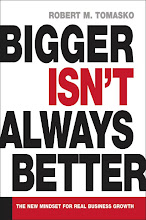September 20, 2006
Dispatches from the front
Fortunately not all enterprises succumb to the quest for bigness. Here are some reports from organizations trying to sustain past successes or turn-around bigness problems.
Microsoft is in the turn-around mode. Ray Ozzie, its new technology czar, says:
It will be interesting to see how he addresses what gets called the core Windows problem. According to Michael Cusumano, a professor at the Sloan School of Management at the Massachusetts Institute of Technology: “Windows is too big and too complex."
The MIT prof thinks that fixing windows will take a radical approach, a willingness on the part of Microsoft to walk away from its legacy.
Apple did this in 2000 when it walked away from OS 9, and again this year when it switched to an Intel-based processor.
(For more detail, see: New York Times March 27, 2006 “Windows Is So Slow, but Why?” by
Lohr and John Markoff)
Apple, whose legacy was not as massive as Microsoft’s, had an easier time walking away. Its big challenge now is sustaining its momentum. Apple’s Jonathan Ive has an interesting take on what’s been behind the company’s success:
Focus on a few things. Care about them a lot. Not a bad strategy for growth.
(For more on Ive see: Business Week September 25, 2006 IN pp. 27-33)
Microsoft is in the turn-around mode. Ray Ozzie, its new technology czar, says:
"Complexity kills. It sucks the life out of developers, it makes products difficult to plan, build and test, it introduces security challenges and it causes end-user and administrator frustration."
It will be interesting to see how he addresses what gets called the core Windows problem. According to Michael Cusumano, a professor at the Sloan School of Management at the Massachusetts Institute of Technology: “Windows is too big and too complex."
The MIT prof thinks that fixing windows will take a radical approach, a willingness on the part of Microsoft to walk away from its legacy.
Apple did this in 2000 when it walked away from OS 9, and again this year when it switched to an Intel-based processor.
(For more detail, see: New York Times March 27, 2006 “Windows Is So Slow, but Why?” by
Lohr and John Markoff)
Apple, whose legacy was not as massive as Microsoft’s, had an easier time walking away. Its big challenge now is sustaining its momentum. Apple’s Jonathan Ive has an interesting take on what’s been behind the company’s success:
“We don’t make very much stuff. That’s a very important part of our approach to what we do, which is not to do a lot of unnecessary stuff but just to focus and really try very sincerely to care so much about the few things that we do.”
Focus on a few things. Care about them a lot. Not a bad strategy for growth.
(For more on Ive see: Business Week September 25, 2006 IN pp. 27-33)
